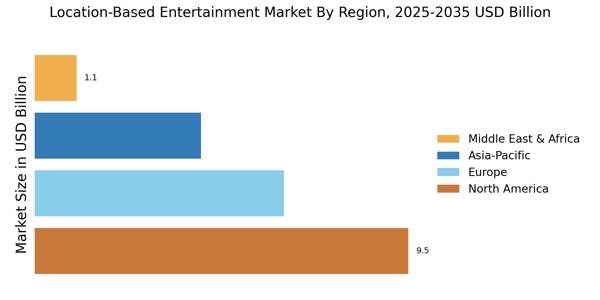Rise of Immersive Technologies
The Location-Based Entertainment Market is experiencing a notable rise in immersive technologies such as virtual reality (VR) and augmented reality (AR). These technologies enhance user experiences by creating engaging environments that captivate audiences. According to recent data, the VR segment alone is projected to grow at a compound annual growth rate of over 30% in the coming years. This growth is driven by advancements in hardware and software, making immersive experiences more accessible and affordable. As consumers increasingly seek unique entertainment options, the integration of these technologies into location-based venues appears to be a key driver for market expansion. The ability to offer interactive and personalized experiences may significantly influence consumer preferences, thereby shaping the future landscape of the Location-Based Entertainment Market.
Emergence of Health and Wellness Trends
The emergence of health and wellness trends is influencing the Location-Based Entertainment Market in various ways. As consumers become more health-conscious, there is a growing demand for entertainment options that promote physical activity and well-being. Venues that incorporate fitness elements, such as active gaming or wellness retreats, are likely to attract a broader audience. Recent data suggests that the wellness tourism market is expanding, with an increasing number of individuals seeking experiences that enhance their physical and mental health. This trend may encourage location-based entertainment operators to diversify their offerings, integrating wellness-focused activities into their venues. By aligning with the health and wellness movement, the Location-Based Entertainment Market could potentially tap into a new demographic, fostering growth and innovation.
Expansion of Urban Entertainment Districts
The development of urban entertainment districts is emerging as a significant driver for the Location-Based Entertainment Market. These districts, which often combine dining, shopping, and entertainment, create vibrant environments that attract visitors. Recent urban planning initiatives have focused on revitalizing city centers, leading to the establishment of mixed-use developments that incorporate various entertainment options. This trend not only enhances foot traffic but also encourages longer stays, thereby increasing consumer spending. As cities continue to evolve, the integration of location-based entertainment within these districts appears to be a strategic move to enhance urban appeal. The synergy between different entertainment offerings within these districts may foster a more dynamic and engaging atmosphere, ultimately benefiting the Location-Based Entertainment Market.
Growing Popularity of Experiential Marketing
Experiential marketing is gaining traction as brands seek to create memorable interactions with consumers, thereby influencing the Location-Based Entertainment Market. This marketing approach emphasizes immersive experiences that engage audiences on a personal level. As brands increasingly recognize the value of experiential campaigns, they are likely to collaborate with location-based entertainment venues to create unique events and promotions. Recent surveys indicate that over 70% of consumers prefer experiences over traditional advertising, suggesting a shift in marketing strategies. This trend may lead to increased partnerships between brands and entertainment venues, enhancing the overall consumer experience. The fusion of marketing and entertainment could potentially drive foot traffic and revenue for the Location-Based Entertainment Market, as consumers are drawn to innovative and engaging experiences.
Increased Consumer Spending on Leisure Activities
Consumer spending on leisure activities has shown a consistent upward trend, which positively impacts the Location-Based Entertainment Market. Recent statistics indicate that discretionary spending on entertainment has increased by approximately 15% over the past few years. This trend suggests that consumers are willing to allocate more of their budgets towards experiences rather than material goods. As a result, location-based entertainment venues, such as theme parks, escape rooms, and immersive art installations, are likely to benefit from this shift in consumer behavior. The growing demand for unique and memorable experiences may drive operators to innovate and enhance their offerings, further propelling the growth of the Location-Based Entertainment Market. This evolving consumer mindset indicates a promising future for businesses that can effectively cater to the desire for experiential entertainment.


















Leave a Comment